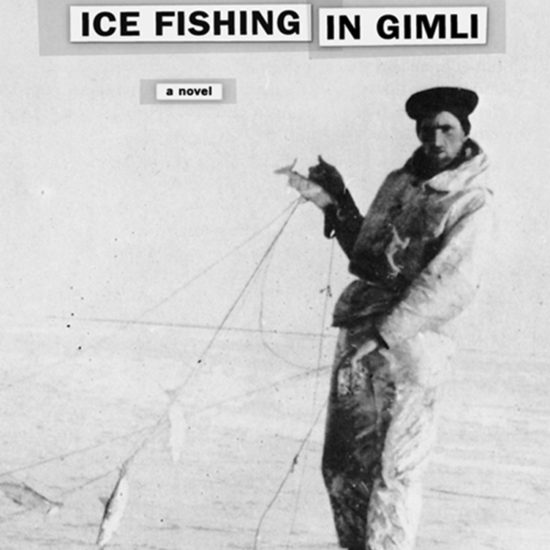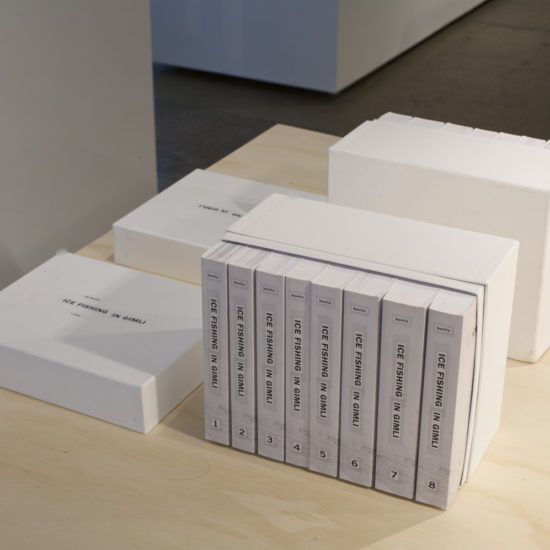Ice Fishing in Gimli (a novel)
December 12, 2009 to February 21, 2010
Opening reception: December 11, 2009 – 8:00pm
Ice Fishing in Gimli is an exhibition based on an eight-volume image/text montage bookwork by Winnipeg artist/writer Rob Kovitz. As a special program offered only to Plug In members, lending copies of the entire eight volume work are available on loan during the exhibition. This exhibition will run from December 12, 2009 to February 21, 2010. The opening reception will be held on December 11 at 8:00 pm. The following day, a conversation with Rob Kovitz and Robert Enright will take place December 12 at 3:00 pm.
Experimental bookwork and sweeping Canadian saga, human comedy and technical treatise, page-turning novel and enigmatic object, Ice Fishing in Gimli is a hybrid creature. Every word and every image in this seven-book, eight-volume epic has been ransacked from other sources. In a radical test of the “fair use” principle, Winnipeg artist Rob Kovitz has constructed a 4,761-page book entirely out of quotations.
Ice Fishing in Gimli is about a place, at the most literal level the town of Gimli and its surroundings, the changeable expanse of Lake Winnipeg and the endless reach of the prairies. It’s a place shaped by primeval geological forces, marked by extreme weather and barely dented by human will. More than anything it’s a place created by words. Kovitz’s massive assemblage builds up in slow, layered accretions of history and myth, utopian dreams and crushing naturalistic necessity.
Ice Fishing in Gimli is also about the people who’ve come to this place, or imagined something like it, or fled from it with only their frozen memories. There are wandering Jews, fatalistic fishermen and stoic farmwives. There are European settlers pole-axed by cold and desolation, and Icelanders gamely publishing newspapers even as they perish of scurvy and smallpox in the hard winter of 1876. Chronicling a constant war between nature and the built environment, Kovitz offers cautionary tales of those attempting to negotiate an uneasy truce: artists, writers and scientists, melancholy architects, deranged civic boosters and obsessive explorers.
Kovitz manages to cram some spectacularly gothic episodes into his work-murder and winter-induced madness, decapitation and drowning, cannibalism and fumbling polar sex. That’s the bait, though, as he drops his hook into colder, deeper waters. The work keeps getting drawn into undertows of void and mass, silence and clamouring thought, Kierkegaardian despair and ecstatic apprehension.
In its content, Ice Fishing is about everything, more or less. In its form, it is about how and why we read. It is the record of Kovitz’s reading, which is curious and generous. And it becomes an examination of our reading, whatever unpredictable paths that might take. Some people will approach the work with old-school start-to-finish determination. Others will wander here and there, strolling through texts, photographs, advertisements and film-stills like page-flipping flâneurs. These different responses reflect Ice Fishing’s hybrid status. The term “bookwork” suggests something between an artwork and a literary text. Locating Ice Fishing in a gallery reinforces the formal qualities of the books themselves, in particular their apt resemblance to white-gray slabs of polar ice. At the same time, the gallery setting challenges the conventional sense of the book’s function, by bringing the novel-which historically has been associated with the exploration of the private self-into a shared space. Many gallery exhibitions of bookworks involve iconic arrangements of chairs, tables and reading lamps, sometimes suggesting scholarly austerity, sometimes replicating comfy domesticity. The exhibition at Plug In ICA involves the creation of a lending library, with specially constructed carrying cases that allow gallery members to takeIce Fishing home for one week. This process positions the work somewhere between object and text, between the public and the personal.
Kovitz is also facing questions about the role of the book in the digital age. Ice Fishing is emphatically bookish, the eight volumes taking up Victorian amounts of shelf space. Viewing it as a last-ditch defence of print is deceptive, however. For one thing, its production and distribution are idiosyncratic: Kovitz sells Ice Fishing through Amazon and through his own website, www.treyf.com, and has exhibited partial versions as works-in-progress at YYZ in Toronto and Gallery One One One in Winnipeg. As well, the ten years Kovitz spent working on the books, from 1999 to 2009, overlap with the expanded capability and availability of the Internet. Originally planned at three volumes, the work eventually multiplied into eight, as Kovitz moved from the labour-intensive research of periodical stacks and library index cards to the rapid hits and quicksilver lateral connections of Google.
Ice Fishing is a 21st-century version of the commonplace book, those intellectual scrapbooks popular in post-Renaissance Europe in which people recorded proverbs and poetry fragments, medical advice and legal doctrines, recipes and botanical sketches. Its method of construction raises questions about the artist’s role in an accelerated, information-saturated culture, in which modernism’s heroic myths of authenticity and originality have been subverted by methods of mechanical reproduction and postmodernism’s magpie impulses of quotation and appropriation. A mash-up of Baudelaire and The Big Lebowski, Patti Smith and prairie mystery-man Frederick Philip Grove, old newspaper photos and scientific reports on the pathophysiology of tissue freezing, the work could be taken as an admission that all texts are about other texts, that all images reference other images. But the project, with its vast scale, vaulting reach and encyclopaedic detail, also feels like a form of slightly crazed creative monomania. Kovitz uses borrowed words to craft something stubbornly singular and unexpectedly personal.
With fluid editing from page to page and a meticulously planned structure from volume to volume, Kovitz absorbs all his wayward sources into an unexpected but integral new form. One of the wonderful puzzles of Ice Fishing is the way Herman Melville’s white whale and Thomas Mann’s magic mountain take on an oddly Canadian complexion, while all the familiar tropes of the 20th-century prairie novel-the dying cattle, the failed crops, the smell of wet wool-feel fresh, even exotic.
“To think people live here through the winter,” writes Kovitz, by way of quoting Canadian novelist Thomas Wharton. Persevering through a prairie winter is a form of folly, perhaps, but Kovitz’s defiantly grand, obstinately unclassifiable work isn’t afraid of folly, whether it’s the folly of fishing in February or the folly of writing a 4,761-page novel when everything has already been said.
-Alison Gillmor







